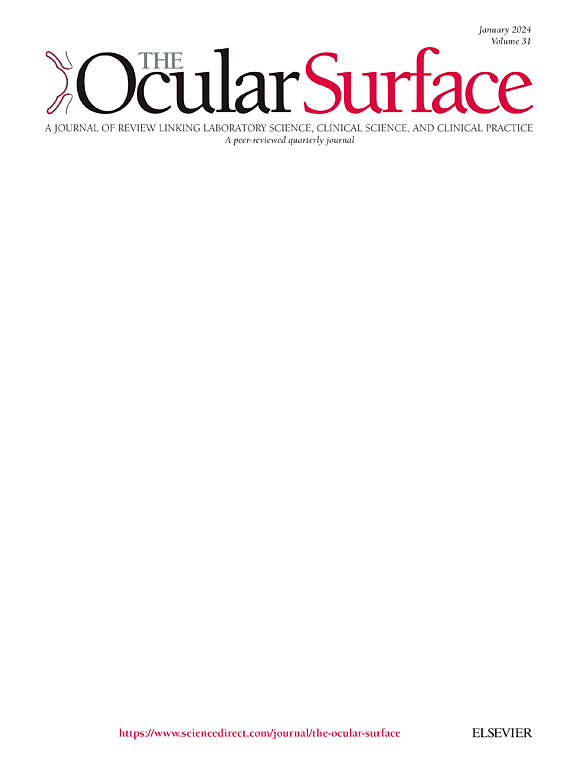Development of human amniotic epithelial cell-derived extracellular vesicles as cell-free therapy for dry eye disease
IF 5.9
1区 医学
Q1 OPHTHALMOLOGY
引用次数: 0
Abstract
Purpose
This study aimed to investigate the therapeutic potential of extracellular vesicles (EVs) derived from human amniotic epithelial cells (hAEC-EVs) for Dry Eye Disease (DED) treatment.
Methods
Highly purified EVs were isolated from the culture supernatants of hAECs, which obtained from term placenta and characterized. Proteomic contents were analyzed for assessing its biological function related to the therapeutic potentials for DED. Subsequently, we examined the therapeutic efficacy of hAEC-EVs on human corneal epithelial cells exposed to hyperosmotic stress and in an experimental DED mouse model induced by desiccation stress.
Results
Proteomic analysis of hAEC-EVs revealed proteins linked to cell proliferation and anti-inflammatory responses. We demonstrated efficient uptake of hAEC-EVs by ocular surface cells. Under DED conditions, EV treatment increased corneal epithelial cell proliferation and migration, and concurrently reducing inflammatory cytokines. In the DED mouse model, hAEC-EVs showed significant improvements in corneal staining score, tear secretion, corneal irregularity, and conjunctival goblet cell density. Additionally, hAEC-EVs exhibited a mitigating effect on ocular surface inflammation induced by desiccation.
Conclusions
These findings suggest that hAEC-EVs hold potential as a cell-free therapy for corneal epithelial defects and ocular surface diseases, presenting a promising treatment option for DED.
开发人羊膜上皮细胞衍生细胞外囊泡,作为干眼症的无细胞疗法。
目的:本研究旨在探讨从人羊膜上皮细胞(hAEC-EVs)中提取的细胞外囊泡(EVs)治疗干眼症(DED)的潜力。方法:从足月胎盘中获得的 hAECs 培养上清液中分离出高度纯化的 EVs,并对其进行了表征,分析了其蛋白质组含量,以评估其与 DED 治疗潜力相关的生物功能。随后,我们研究了 hAEC-EVs 对暴露于高渗透压下的人角膜上皮细胞和干燥应激诱导的实验性 DED 小鼠模型的治疗效果:hAEC-EVs的蛋白质组分析显示了与细胞增殖和抗炎反应相关的蛋白质。我们证明了眼表细胞对 hAEC-EVs 的高效吸收。在 DED 条件下,EV 处理增加了角膜上皮细胞的增殖和迁移,同时减少了炎症细胞因子。在 DED 小鼠模型中,hAEC-EVs 能显著改善角膜染色评分、泪液分泌、角膜不规则性和结膜上皮细胞密度。此外,hAEC-EVs 对干燥引起的眼表炎症也有缓解作用:这些研究结果表明,hAEC-EVs 具有作为角膜上皮缺陷和眼表疾病无细胞疗法的潜力,为 DED 的治疗提供了一种前景广阔的选择。
本文章由计算机程序翻译,如有差异,请以英文原文为准。
求助全文
约1分钟内获得全文
求助全文
来源期刊

Ocular Surface
医学-眼科学
CiteScore
11.60
自引率
14.10%
发文量
97
审稿时长
39 days
期刊介绍:
The Ocular Surface, a quarterly, a peer-reviewed journal, is an authoritative resource that integrates and interprets major findings in diverse fields related to the ocular surface, including ophthalmology, optometry, genetics, molecular biology, pharmacology, immunology, infectious disease, and epidemiology. Its critical review articles cover the most current knowledge on medical and surgical management of ocular surface pathology, new understandings of ocular surface physiology, the meaning of recent discoveries on how the ocular surface responds to injury and disease, and updates on drug and device development. The journal also publishes select original research reports and articles describing cutting-edge techniques and technology in the field.
Benefits to authors
We also provide many author benefits, such as free PDFs, a liberal copyright policy, special discounts on Elsevier publications and much more. Please click here for more information on our author services.
Please see our Guide for Authors for information on article submission. If you require any further information or help, please visit our Support Center
 求助内容:
求助内容: 应助结果提醒方式:
应助结果提醒方式:


